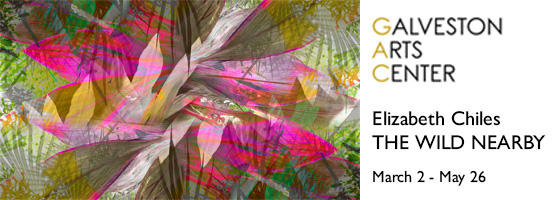It’s no exaggeration to say that Spirit Lodge: Mississippian Art from Spiro, on view at the DMA March 13-Aug. 7, could be the last time a show of this magnitude comes around, at least in our lifetime. It’s not only because of its size—nearly 200 objects—but also the sheer difficulty of actually bringing them together under one roof.
For some context on the objects within the collection, we should first start with a little history of how they got there. The Mississippian civilization flourished over the course of approximately 800 CE to 1600 CE. Their massive geographical footprint stretched as far north as present-day Illinois, as far south as Louisiana, east to Florida, and west to Oklahoma.
Archaeologists believe that the civilization was as sophisticated as those of the other ancient societies of Mexico or Central and South America. So why aren’t they as prominent today? It has a lot to do with how they constructed their world. The Mississippians built their cities and ritual centers primarily out of earth and dirt mounds, as opposed to the cut stone masonry architecture characteristic of the Aztec, Maya, or Inca.
This historical overview sets up the exhibition’s second portion and focuses on the namesake of the show, which unexpectedly also turns into a miniature environmental lesson: In approximately 1400 CE, the world’s North Atlantic region experienced what’s now defined as the “Little Ice Age.” The extreme droughts that came along with it were devastating to the agriculturalists, whose survival depended upon their crops.
“We’re looking at an ancient culture that was dealing with climate change on the scale of what we’re experiencing today, and they approached it in the way that they understood,” explains Dr. Rich. “’How do we mitigate this? What can we do to intercede or to stop this from happening? How do we reset the clock? How do we get rid of this cycle of drought?’”
The Mississippians’ answer was to create a ritual renewal of the world. They assembled countless objects within a chamber—a spirit lodge—to pay homage to culture heroes and deities associated with the world’s original creation. Over the course of generations, ritual objects were brought to the chamber built inside of an earthen Craig Mound in Spiro, a site located in present-day Eastern Oklahoma. The hopes were that, by doing so, the deities would restabilize climate.
Unfortunately, it didn’t work.

1 ⁄9
Chase Earles and Starr Hardridge, Caddo and Muscogee (Creek), EVERLASTING FIRE PLATE, 2019, acrylic and plaster on ceramic, National Cowboy & Western Heritage Museum, 2019.35

2 ⁄9
Chase Kahwinhut Earles, Caddo, Horse Tripod Vessel (Deé-Tumbah Kah’-Wis), 2015, ceramic, National Cowboy & Western Heritage Museum, 2018.12

3 ⁄9
Damion Jay McGirt, Muscogee, Beaded bandolier bag, 1998, North American Southeast, cloth, beads, National Cowboy & Western Heritage Museum. 1998.53

4 ⁄9
Effigy pipe of seated male figure, known as Resting Warrior or Big Boy, and identified as Morning Star or the hero Red Horn, Leflore County, Oklahoma, Spiro site, 1100 – 1200 AD, bauxite (flint clay), Fayetteville, University of Arkansas Museum, 47-2-1. Image courtesy The Nelson-Atkins Museum of Art, Media Services. Photo: John Lamberto.
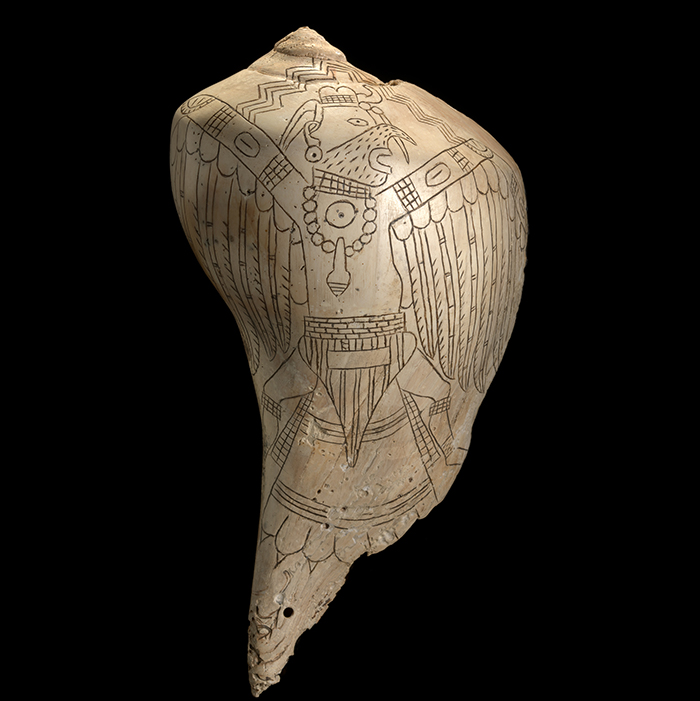
5 ⁄9
Engraved shell medicine cup, Leflore County, Oklahoma, Spiro site, 1200 – 1450 AD, marine shell, National Museum of the American Indian, Smithsonian Institution, 18912.
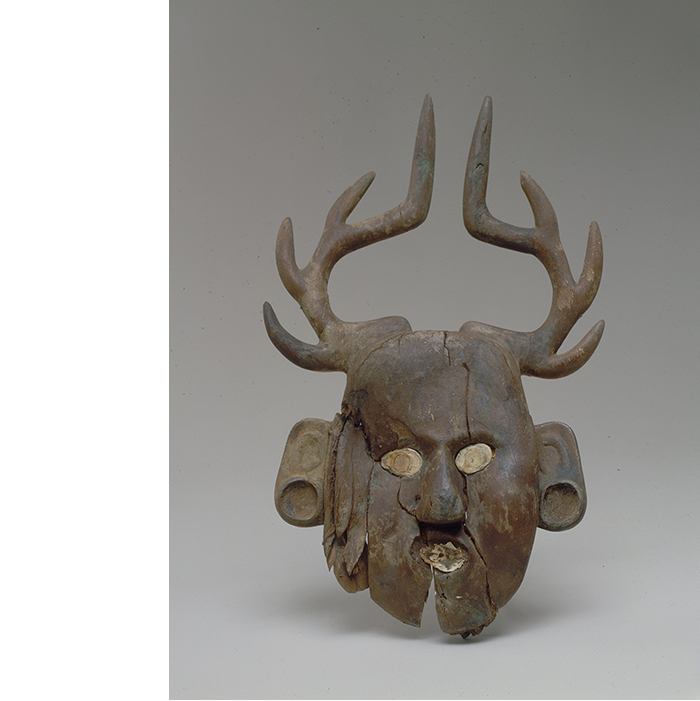
6 ⁄9
Human face effigy with deer antlers, Leflore County, Oklahoma, Spiro site, 1200 – 1450 AD, wood, National Museum of the American Indian, Smithsonian Institution, 18930.
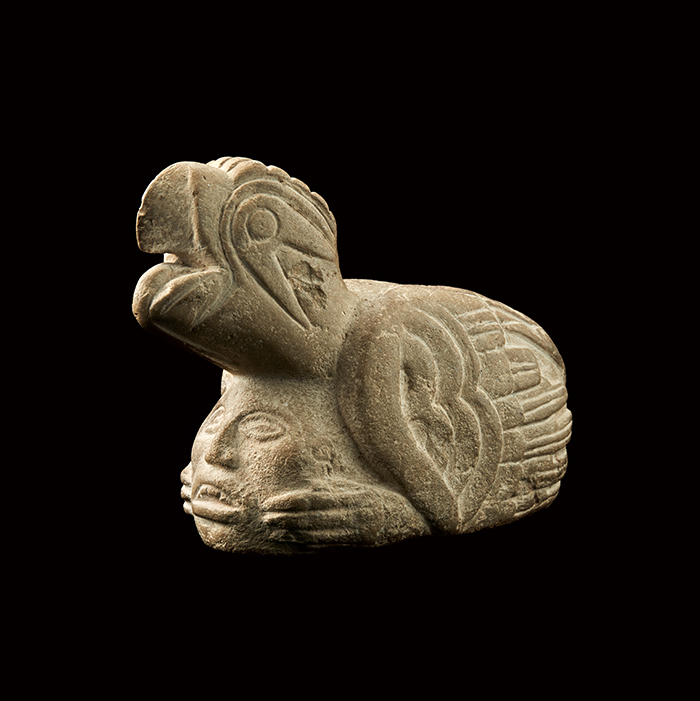
7 ⁄9
Raptor with human head effigy pipe, Plaquemine, Issaquena County, Mississippi, Esperanza Place, AD 1200–1400, stone, Gilcrease Museum, Tulsa, Oklahoma, GM 61.1206
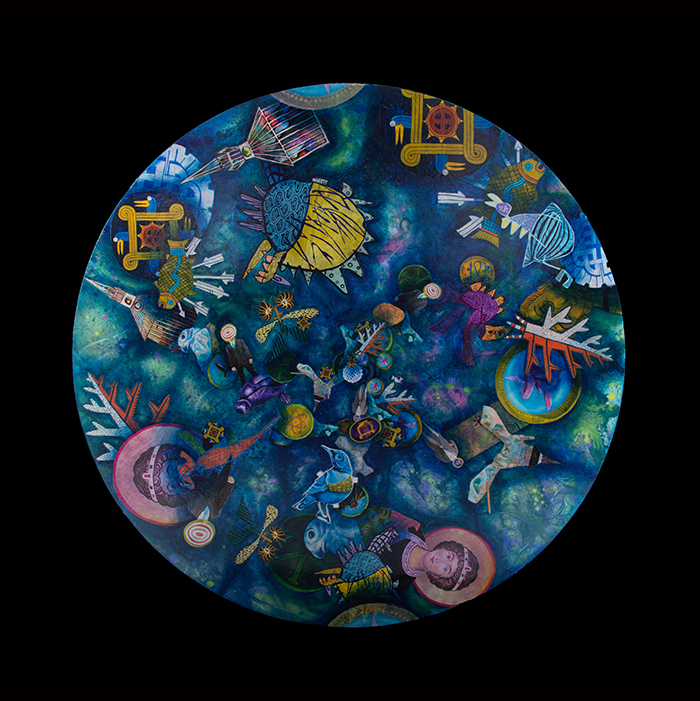
8 ⁄9
Erin Shaw, Chickasaw, EVERYTHING BELONGS, 2013, mixed media, National Cowboy & Western Heritage Museum, 2017.08

9 ⁄9
Starr Hardridge, Muscogee (Creek), COSMIC TWINS, 2016, acrylic and plaster on canvas, National Cowboy & Western Heritage Museum, 2019.17.
Fast forward to the 1930s, when looting of Spiro’s objects resulted in near detriment. It was so severe that legislation was quickly enacted to end the plundering and mandate proper scientific archaeological excavation. But it was almost too late. According to Rich, since no one knows just how many objects were actually within the spirit lodge prior to the looting, there’s an unknown number of objects around the world today. However, further excavation of the remaining items has provided some insight into Mississippian art and the people who created it. Elaborately engraved shell cups suggest sophisticated routes of trade and exchange among early indigenous groups. Stone carvings in the form of humans, animals, and mythical beings demonstrate similarities to other cultures previously seen as disparate.
“We’ve got similar concepts that we can see in art from the Mississippian world down to the Maya world, and into Panama and that region we call the Isthmo-Colombian area,” Rich explains. “Those kinds of connections bring cultures together more than they separate them.” Intricately carved pipes, wooden sculptures, some copper works, textiles, basketry, and thousands of beads and pearls provide further insight into the complexities of the Mississippians’ society and its rituals.
As a person who wears hats as both an archaeologist and art curator, Dr. Rich hopes Spirit Lodge invites visitors to a world with which they’re unfamiliar. “Whether that’s the ancestral world, the ancient world, or the contemporary world,” she says, “I think this show can really open a lot of new doors for our visitors to learn about different cultures and different peoples, their artistic traditions, and their cosmological worldview.”
—AMY BISHOP



